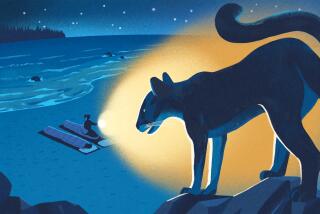Man Moving In but Cougars Staying Put : Wildlife: A continuing study of mountain lions in Orange County has found that the cats avoid humans but often venture into developed areas.
- Share via
The telltale signs were all there: flattened brush where a mountain lion had dragged a slain deer down into the gully, a discarded rumen, and neat piles of leaves where the lion had buried its kill to keep it fresh and cool after each nighttime feeding session.
Paul Beier kicked through the leaf piles until he found what he was looking for--lion scat, a lower mandible, leg bones. He carefully bagged the scat for laboratory analysis of the mountain lion’s diet, and estimated the deer’s age and sex from a quick examination of the bones.
“Looks like it was a female, maybe 2 or 3 years old,” he said, snapping off a piece of a leg bone under his boot. “We’ll take this one back and analyze the marrow for fat content--see what kind of shape the deer was in.”
Such are the tasks of Beier and his assistants, hired by Orange County to conduct a study of the mountain lion population in the Santa Ana mountains. Since early 1988, they have tracked and collared more than a dozen mountain lions, carefully plotted their movements with electronic tracking devices, examined prey and carcasses and tried to monitor the precarious existence of several litters of cubs, which are too young to be collared.
The initial two-year study, prompted by two extraordinary maulings of children in Ronald W. Caspers Wilderness Park in 1986, has been extended and will probably continue another three years, said Beier, a wildlife biologist from UC Berkeley. That should give the researchers enough time to learn about the dynamics of the local mountain lion population--currently estimated at 25 to 40--their effect on the deer population, their encounters with humans, pets and livestock, and the impact of encroaching development on their behavior.
The study has already yielded a good picture of many of the mountain lions’ habits. They’ll eat opossums and other small prey and on rare occasions take a sheep or domestic goat. But 93% of what they eat is deer, usually male. An adult mountain lion kills a deer about every 10 days and feeds on it for three or four nights, burying it each morning before moving off to its daybed. Their home ranges may encompass 100 square miles and overlap. Cub mortality is high, and sometimes mountain lions kill each other, possibly in competition for territory.
For the most part they avoid contact with people, although they cross paved roads and often venture into developed areas, apparently undisturbed by human activity.
One mountain lion--F2, an older female--recently spent a day in Arroyo Trabuco, a thin strip of undeveloped land almost surrounded by construction activity.
“F2 spent the day in a small canyon on the east rim of the Arroyo about 500 meters from a street sign (Antonio Parkway) placed incongruously in the pasture,” Beier wrote in his Feb. 1 report. “Bulldozers were busy making a street for the street sign to mark, with the road cut about 150 meters east of the lion. Within easy view of the lion to the north were golfers on the Rancho Santa Margarita course and to the west were hundreds of homes under construction between Marguerite Parkway and the Arroyo bluffs.”
What amazed Beier was that F2 and other mountain lions were using the area at all; F2 had not visited the area for three years, and development had made access to it even more difficult.
“How much longer will they keep using it?” Beier said, overlooking the canyon where construction proceeded unabated. “There are cougars alive who can remember when there weren’t any houses out there. How will their kids learn how to use it?”
Young mountain lions, about a year old, are typically the ones that get into trouble as they separate from their mother and go off to establish their own ranges, Beier explained.
“They’re like teen-agers going off to find a home,” Beier said. “They’re newly independent, they might not be that skilled at hunting and they might be hungry. . . . So they see a cat or a dog, take a bite out of it and get shot for it.”
While a bereaved pet owner’s anger at the offending animal is understandable, it’s not really the mountain lions’ fault, Beier said.
“They’re killing machines,” he said. Small, defenseless animals such as sheep or goats “are like corn chips for a lion. They’ve got a big sign on their necks that says, ‘Eat Me.’ ”
More to Read
Sign up for Essential California
The most important California stories and recommendations in your inbox every morning.
You may occasionally receive promotional content from the Los Angeles Times.













